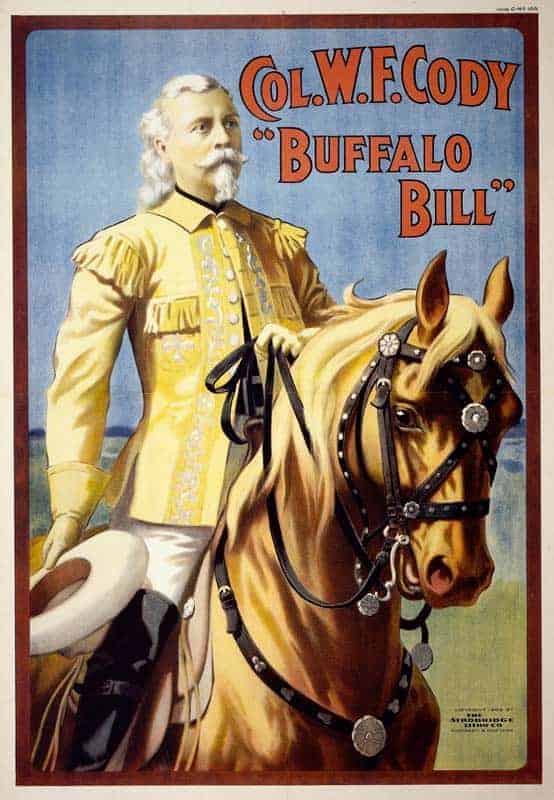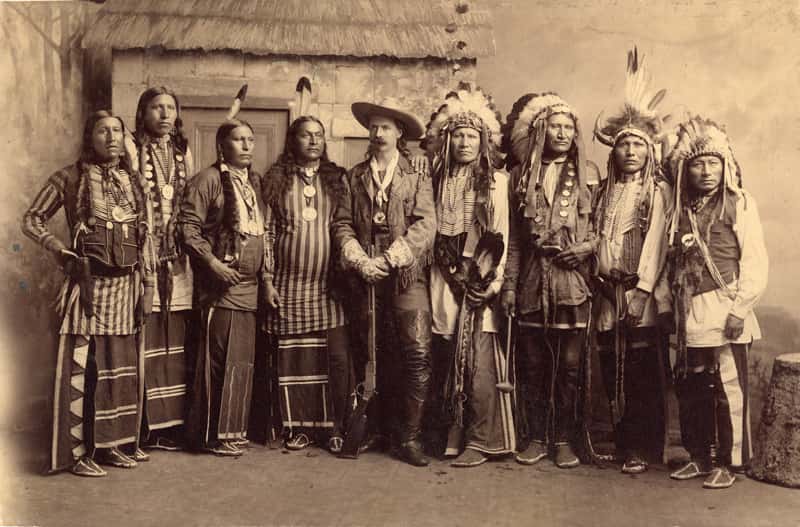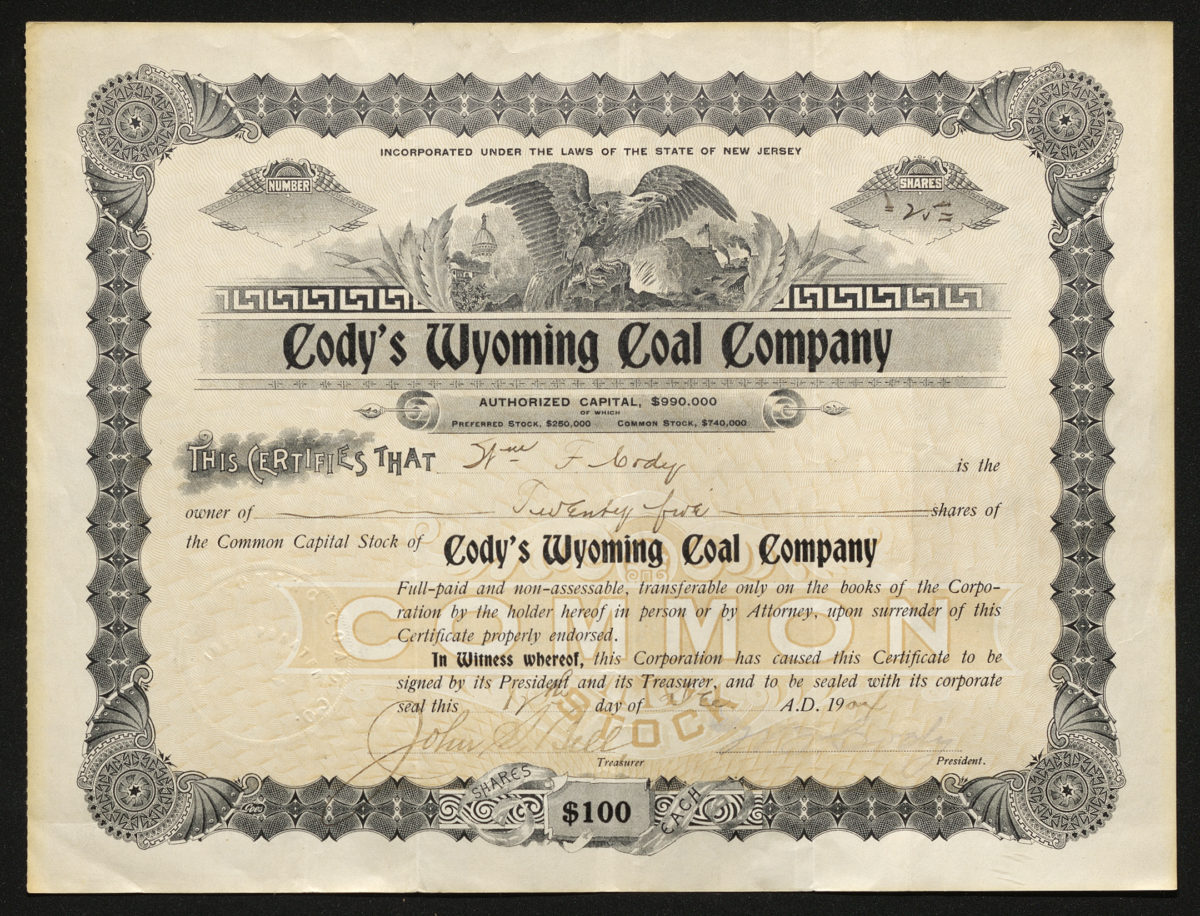
Buffalo Bill Cody: Romancing the Western Frontier
Known as a rugged frontiersman and skilled buffalo hunter, William F. Cody was progressive for his time. He advocated for Native American and women’s rights and for the protection of an over-hunted buffalo population. Cody’s Wild West show herd (consisting of only 18 animals) was the fourth-largest in the United States in 1888 and many buffalo alive today are direct descendants.
Header Image: Buffalo Bill Poster, 1908; author The Strobridge Lithograph Co. courtesy The William F. Cody Archive [1].
“But the West of the old times, with its strong characters, its stern battles and its tremendous stretches of loneliness, can never be blotted from my mind.”

William F. Cody with Lakota and Pawnee Indians; courtesy The William F. Cody Archive
Cody built on his reputation as a soldier, hunter, and cowboy to become a successful businessman and showman. His adventures encapsulated the intrigue and romance of the western frontier. He was recruited by a friend, Ned Buntline, to play himself in a stage production, Buffalo Bill, the King of the Border Men. Building on the success of the play, Buntline convinced Buffalo Bill to act in the wildly popular play The Scouts of the Plains, where Cody polished his “Buffalo Bill” stage persona.
He soon set out on his own to found ‘Buffalo Bill’s Wild West’ in 1883, a traveling show featuring recreations of Pony Express rides, staged Indian attacks on wagons, stagecoach hold-ups, and a reenactment of Custer’s Last Stand. Over the years the show featured a cast of characters of the wild west including Annie Oakley, Sitting Bull, Calamity Jane, and Buck Taylor, and was successful enough to tour America and Europe—even performing for Queen Victoria’s Golden Jubilee in 1887.
With the success of the Wild West show, Buffalo Bill began to invest his profits. One of his investments was in Cody’s Wyoming Coal Company in the early 1900s. The mine sat near the town of Cody, Wyoming, which Cody helped found and is today home to the Buffalo Bill Center of the West. Ever a showman, Buffalo Bill capitalized on his celebrity status to promote the sale of stocks in his coal company. As author Robert E. Bonner writes:
The prospectus for Cody’s Wyoming Coal Company made the usual claims for the quantity and quality of the product, the ease of its extraction (mine was located in the Burlington Railroad cut), and the strong market for coal all along the Burlington line. It went on to point out that “not the least important ingredient, guaranteeing the success of this enterprise, is the forceful personality of Col. Cody.” As a “true pioneer,” possessed of “varied experience, rugged honesty and indomitable energy,” he has the “resources to surmount whatever difficulties he may encounter.”
The coal sold locally in the town of Cody, but the quality was too low to be sold in larger markets. He ultimately lost money on his mining investments as investments like the Cody Coal Mining Company floundered. (Scroll down to continue reading about Cody’s Wyoming Coal Company below)
Cody has faintly signed this certificate as the company’s president, but it is also worth noting the signature of the company’s secretary, John S. Bell. Bell was a good friend of Cody, and former director of the U.S. Secret Service (1888-1890). He oversaw the agency in 1890 when there was an assassination attempt made against President Benjamin Harrison. Bell was often mistaken for Buffalo Bill Cody due to his long hair and wild west aesthetic.
Despite his reputation as a rugged frontiersman and skilled buffalo hunter, William F. Cody was a remarkably progressive thinker. Shocked by over-hunting of buffalo, he advocated for government policies to protect and conserve herds. Buffalo were so decimated by hide-hunting that by 1888, the buffalo herd that Cody maintained for his Wild West show was the fourth-largest in the United States. It was comprised of a meager eighteen animals; many buffalo alive today are descendants of his herd.
Buffalo Bill also used his fame and stature to advocate for social issues including equal rights for Native Americans and women. Cody ensured that Native Americans traveling with his show were treated well. Even though his show cast American Indians attacking wagon trains, he believed that they had the right to fight to defend themselves against American aggression and oppression. Cody similarly cast many strong women in his show and praised their abilities.
Lorraine Boissoneault with the Smithsonian Magazine notes that when asked if he supported the women’s suffrage movement, Cody told a reporter “I do. Set that down in great big black type that Buffalo Bill favors woman suffrage… These fellows who prate about the women taking their places make me laugh… if a woman can do the same work that a man can do and do it just as well, she should have the same pay.”
Cody died of Kidney failure in 1917 and was buried atop Lookout Mountain in Golden, Colorado as per his final request. He had earlier requested to be buried in Cody, Wyoming, leading to a dispute over his remains. The controversy over his final resting place became so heated that his grave site was paved over with tons of concrete to prevent his body from being taken, and at one point the Colorado National Guard was posted to protect the grave.
 University of Nevada, Reno
University of Nevada, Reno
